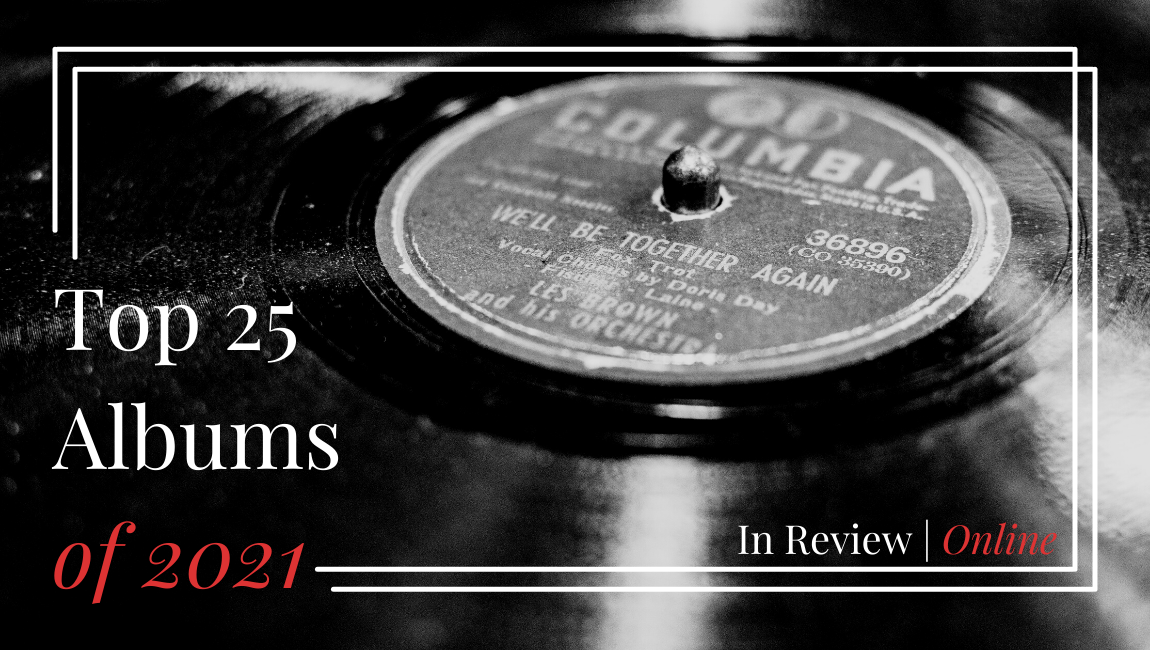One day more until our Top 5 Ablums of 2021 are revealed, but we’re stopping over at #6-10 in the meantime, which reflect perhaps the most eclectic quintet in our countown. Most albums, even if we previously covered them, have been revisited with new words and new writers, and everything in our Top 10 has been given this treatment. Check out our full Best Albums coverage (including our Honorable Mentions) all this week!
10. Bladee
Though prolific and trendy, Bladee remains a figure seemingly detached, his career thus far skirting up against, and indebted to, the western pop music machine, but resistant to its expectations. Alongside collaborators Ecco2K, Thaiboy Digital, and Whitearmor, Bladee has released a slew of tapes, EPs, and albums under the Drain Gang collective banner over the last seven years, yet the culture they’ve fostered has remained as insular as it is devout. Sort of an offshoot of Yung Lean’s Sad Boys and the version of cloud rap music they popularized, the interview-shy crew of (primarily) Swedish producers and autotune-heavy rappers surely prefer it this way, unique enough to inspire a fervent fan base, while just esoteric enough to confound corporate media.
Bladee’s fifth solo album since 2016, The Fool marks a glorious refinement of this balance, pulling the numerous aesthetic threads running through his discography together. His records being known for their individual stylistic consistency already (encouraged by a reliance on one producer per project), The Fool proves Bladee’s most streamlined offering to date, presenting his most recognized sonic predilections fully realized. But the appeal of The Fool is its seeming indifference to such metrics, the album casting Bladee as the title tarot figure, a seeker and learner open to reinvention and discovery. Fitting for the often wide-eyed, new-agey MC and his psychedelic worldview (most apparent here in the existential ruminations of “I Think…”), particularly as it intersects with his mischievous performance of hip hop boastfulness (“Its kinda funny cause you’re so mad and IDGAF”). One can imagine the many ways in which this synthesis could come off as distasteful, and certainly such criticisms have been made and still circulate, but Bladee’s guileless bars and kind sentiment have a way of disarming. Here they’re freestyled over classic post-Lean type production from RipSquad’s Lusi (trap drum versus goofy warbly synth), a newer addition to the ever expanding Drain Gang universe totally in sync with their vibe. Ever evolving and reinventing, The Fool is a natural archetypal figure for Bladee to identify with, his career up till now an unpredictable adventure defined as he went along. Amusingly, The Fool proves his most assured work yet, far out ahead of any number of 2021 albums by more wizened artists in fact, but the title’s humble implications stoke excitement in the suggestion that we only have more Drain ingenuity to anticipate. M.G. Mailloux
9. Wild Up
Repeated phrases, static harmony, and buoyant notes passed along an ensemble have been broadly heard throughout 2021, a year marked musically with minimalist composition. The influence has been seen across many genres: on third stream masterpiece “Promises” by Pharoah Sanders, Floating Point, and the London Symphony Orchestra, the orchestra mysteriously repeats a motif as Sanders longingly sails on top of it. Elsewhere, “Track X” by Black Country, New Road, “Man Is Like a Spring Flower” by Lingua Ignota, and much of Kaatayra’s album Inpariquipê‘ explore minimalist instrumentation and composition while applying it to their usual sounds, chamber art-rock, classically-influenced avant-folk, and avant-garde folk metal, respectively. The minimalist movement, started in the 1960s and most associated presently with Steve Reich and Philip Glass, has an, until recently, overlooked forefather in queer, Black pianist and composer Julius Eastman. Los Angeles-based chamber ensemble Wild Up has set out to record Eastman’s work, a task that’s not as easy as it might otherwise be since his notation style was unusual and much of his work was impounded by NYC sheriffs. On their first volume (of a proposed seven), Wild Up has recorded Eastman’s most famous piece: the ruminative, playful masterpiece “Femenine.” Until now, the most vital recording of the chamber piece came from the SEM Ensemble, in which Eastman played piano. Compared to that, Wild Up’s Julius Eastman, Vol. 1: Femenine is more jubilant and jazzy, breaking free from the piece’s unshakeable motif more often and more wildly.
But what precisely is the motif here? A jubilant note repeated, usually marked with 12 sixteenth notes, followed by a lengthening and a deliberate major 2nd, oft repeated thrice. Split into ten movements and starting with ambient sleigh bells, the first movement on Wild Up’s album-length recreation is plaintive, with an nostalgic piano solo and leading into a more exuberant second movement, one incorporating a growing ensemble on the motif, more winds and more percussion added to enrich the chord. A slight screech is perceptible in the background, indicating change which comes in the form of baritone saxophone, beefily overtaking the melody before bending its pitch and timbre in a mysterious, thoughtful solo. In movement three, the motif’s rule temporarily subsides and the ensemble chirps together, traveling away and arriving at the familiar percussive rhythm in an impressionistic fashion. In “Hold and Return,” more low saxophone returns, overpowering the duhladuhladuhladuhladuhladuhladuhladuhla completely, exercising extended techniques by overblowing, jumping octaves, and approaching multiphonics. Next comes the stately, aptly-titled “All Changing,” where the horns and piano elegantly trade notes and the motif dramatically changes, almost disappearing. This leads into diverse solos: babbling vocalization, a charming flute, and a luxurious trumpet; later, alto sax and deep reed grow alongside dueting vocals. Briefly, when the group comes together to resume the motif, it nearly sounds like a glitch. But then the seventh movement, “Eb,” which sounds like a party, with several of the voices conversing privately and festively, the piano and marimba moving beautifully through the chatter, resulting in an inspiring soundscape sometimes shaken up with bright yet uncomfortable quarter notes played in unison. Movement 8, “Be Thou My Vision / Mao Melodies,” features a very evenly played piano solo, traveling march-like until a pastoral flute interrupts, quieting the whole ensemble until they come back again to the motif, but the interval is increased this time, although not for long. “Can Melt” is largely a winding-down ramble, but with the threat of those bright unisons penetrating, until, finally, “Pianist Will Interrupt Must Return.” And return we do; to quiet and sleigh bells, which we hear for minutes after the final motif resolves. In ten wondrous movements, Wild Up has produced a work both revolutionary and respectful of Eastman’s seminal piece, and it has arrived right as minimalism finds itself folding into other genres, exactly as Eastman preferred. Tex Stechnij
8. Lana Del Rey
As easy as it is to recognize the old spirit that Lana Del Rey has always been, it’s just as easy to see how eager the (in?)famous artist is to still explore new(er) territories with her music. And so, rather than becoming indolent or oversatisfied with Norman Fucking Rockwell!’s immensely beloved reception from both fans and critics alike, 2021 saw her defiantly push herself (and her listeners) out of any comfort zone. Chemtrails over the Country Club (the first of two records she released in 2021, along with Blue Banisters) sees Lana in autofictional, wanderlust mode, leaving behind her typically Californian soundscape — “I’m ready to leave LA / And I want you to come / Eighty miles North or South will do” — in order to commence a sonic journey (or more accurately, road trip) through suburban Americana. And indeed, one quality is always certain in Lana’s work: the weaving of hopeful musings and personal introspections into contemporary compositions, fusing the dreams of yesteryear with a hip, distinctly modern awakening.
From Orlando in “White Dress” to Arkansas and Oklahoma in “Tulsa Jesus Freak,” from the Nebraska of “Not All Who Wander Are Lost” to “Dance Till We Die” in Louisiana, Lana paints a (semi-)national panoramic canvas cut through with a strong sense of nostalgia and deliverance — less Beat movement than the kinetic, rebellious runaway character of Bonnie and Clyde mythos; no longer fixed in Long Beach or Venice Beach, but instead drifting toward open ranches and meadows — to narrate themes of childhood and womanhood in a masterful storytelling fashion. In fact, Chemtrails can frequently feel as if Lana is treating each song — and their particular poetry — as a work of captured polaroid photography, a snapshot of place and time. It might not be accidental, then, that her compositions and lyrical imagery, perhaps more than ever, are here energized through the constant effects of sunbeams and summer lights, preserving a very hazy quality — also notable in the way she experiments with her most delicate vocal reaches, embracing previously lesser-heard timbers and pitches, on exceptional display in “Dark But Just a Game.”
Full of delightful details, it’s plenty enough to just listen carefully to how literally colorful Lana’s poetic palette on Chemtrails is — “When I was a waitress wearing a white dress”; “We could get lost in the purple rain… / We could get high on some pink champagne”; “I remember watching, How Green Was My Valley” — while also seizing on the pleasure of listening to her mark time’s transience — “Winter to Spring / Spring back to Fall / Isn’t it cool how nothing here changes at all?” White-hot and wild, as the record moves forward from more piano-centric pieces to largely guitar-driven tracks, Chemtrails takes final shape as a kind of downtempo, trippy dance. The soft, moody percussion and the ambient trip-hop texture drive the project’s atmosphere and help enunciate the presence of guest artists like Nikki Lane, Zella Day and Weyes Blood, imbuing the record with yet another layer of vitality. And while Lana’s seventh studio album finds her committing to following in the footsteps of obvious idols like Joni Mitchell and Joan Baez — “I’m coverin’ Joni and dancin’ with Joan” — it’s perhaps more effective to regard Chemtrails over the Country Club for Lana as what Song of the Open Road represents for her artistic father figure, Walt Whitman: a work that, above all, is very “afoot and light-hearted.” Ayeen Forootan
7. Playboi Carti
Arriving at the tail end of 2020 — Christmas Day, to be exact — to the bewilderment of fans and skeptics alike, Playboi Carti’s Whole Lotta Red was finally delivered to the world after months of hyper-speculation and a slew of false starts (including an appropriately named mid-tier single “@MEH” sorta coming and going). There wasn’t much in the way of a traditional promotional run leading up to release — if anything, more interest was garnered through leaks — and the closest thing this had to any major press coverage was DJ Akademiks calling Carti “Santa” a week prior because of the “gift” he was about to bestow on the upcoming holiday. The already illusive Atlanta performer went full incognito mode for two years, communicating only through sticky caps tweets that looked like cryptic symbols (giving new meaning to the line “They can’t understand me, I’m talkin’ hieroglyphics”) and occasionally providing a hot feature or two. For any other rapper, that would be career suicide; for Carti, this was a test of loyalty for his cult-like following, one he had developed after Die Lit, but even the most ardent of his supporters were starting to get restless. It was a waiting period that produced a mystifying, abstruse reward: one that wasn’t simply Die Lit 2 — made explicitly clear with those hazy, disorienting first few seconds of “Rockstar Made,” with that fiendish leading piano melody and those blown-out, looping 808s — but an evolution of that record’s sonic sensibilities, with the “rockstar”-oriented aesthetic taken to its natural conclusion. More specifically, it was a progression from mumble rap into punk rock; or, trap music’s succinct, hard-hitting sonic character correctly placed within punk’s musical lineage.
So Carti wasn’t trying to emulate Kurt Cobain anymore, he was now a vampiric reincarnation of Sid Vicious. He no longer muttered his lyrics, but on Whole Lotta Red bellows them until he runs out of energy; he barks the chorus of “Stop Breathing” until he literally stops breathing and phonetically spits out “D-R-A-C-O” over “On That Time”’s sputtering beat as if his life depended on it. Half of the time he’s a demonic necromancer, a gothic creature of the night (“No Sl33p” has him dreaming about murder); the other half, an oddball, an aloof goof (his Lil Uzi Vert-like intonations on “Slay3r”). There are occasions where Carti’s high-register “baby voice” emerges — he squeaks through “Teen X” with an equally shrill Future — but his trademark delivery has been tweaked, refined, and overall retooled for the occasion, a testament to the degree to which his artistry continues to advance. In fact, his progressive gambit here isn’t all that different to the likes of what executive producer Kanye West achieved with Yeezus in 2013: to plunge into an abrasive unknown and come out a brand new person. But even this overstates how much Whole Lotta Red adheres to any sort of tradition or, hell, even much of anything else in contemporary hip-hop. Sure, there have been a lot of artists who have wanted to emulate Whole Lotta Red’s particular swagger and sound after its release — Trippie Redd released a pretty good knockoff album a little later — but Carti’s rage music is instinctually his own beast. Even at a year out, it remains an unprecedented, explosive statement from one of the more perplexing figures to emerge from the SoundCloud scene; to this day, we’re still picking up pieces of the shrapnel. Paul Attard
6. dltzk
Given the current character of the music industry,“online music” is quickly approaching obsolescence as a useful label — if ever it was one. The relationship between mainstream studio acts and Internet artists has become something of a closed loop, the latter taking inspiration from the former’s work in the creation of a new, followed by a subsequent role-reversal. But if this dynamic is to be understood more as ouroboros, an interdependence pushing toward some epochal artistic terminus, there are few worthier prophets to usher in a new musical world than dltzk, the 18-year-old New Jerseyite producer of moody digicore pop.
Perhaps the best entry point to dltzk’s sound is an understanding of who they’re not. Certainly, there’s a distinct melange of influence — or at least kinship — here, from the shoegaze electronica of Porter Robinson to the avant-pop of 100 gecs to the cloud rap of Bladee and lo-fi/pop-punk rap of Peep, but debut record Frailty is something entirely new, a genre-shifting work of simultaneous sonic expansion and assimilation. The album kicks off in earnest with second track “your clothes,” a masterful work of emo that feels filtered through an especially twitchy anime soundtrack. It’s a song that moves in waves, sonically and lyrically, its tempo and activity made to match its mercurial lyricism: “At least you know my name / I always change the channel when the couple starts to kiss.” Frailty blooms from this moment, a gyre of authentic Zoomer lamentations and wunderkind digital orchestrations, the album’s fuzzed out mix and glitchy progressions lending a grimy texture to its haze of buildups and breakdowns, dance-y drops and age-specific hauntings. But it’s the nearly 6-minute “movies for guys” that offers the best showcase of dltzk’s prodigious whiz-kid skill. Starting out in a blurry approximation of late-aughts radio pop, the track detours into a brief hardcore-inflected interlude before coming out the other side in pronounced GothBoiClique, croon-rap mode. It’s a song rife with genre waypoints, but Frailty’s brilliance comes in never slowing down enough to trade in mere nostalgia, and instead accelerating through each locus of inspiration until the muzzy mix becomes something entirely new. It’s a forward-looking work that only youth could produce, the difference between recycle and reinvention, and where the former has failed to save our planet’s future, dltzk has positioned himself as the potential savior of music’s immediate present. Luke Gorham












